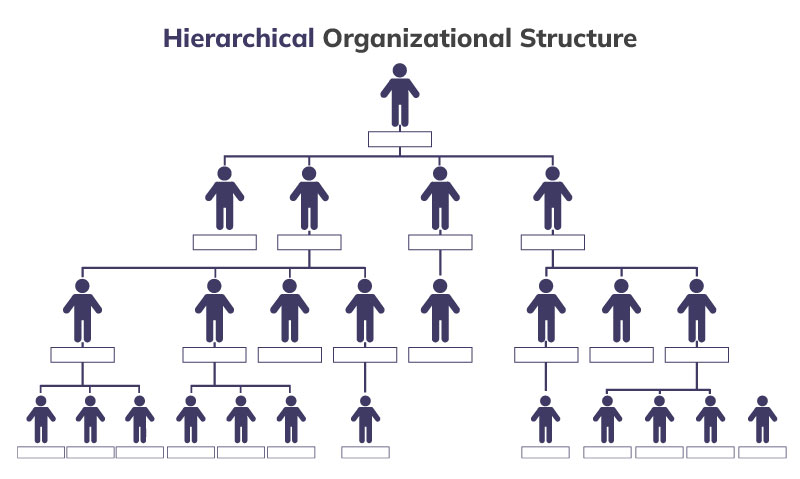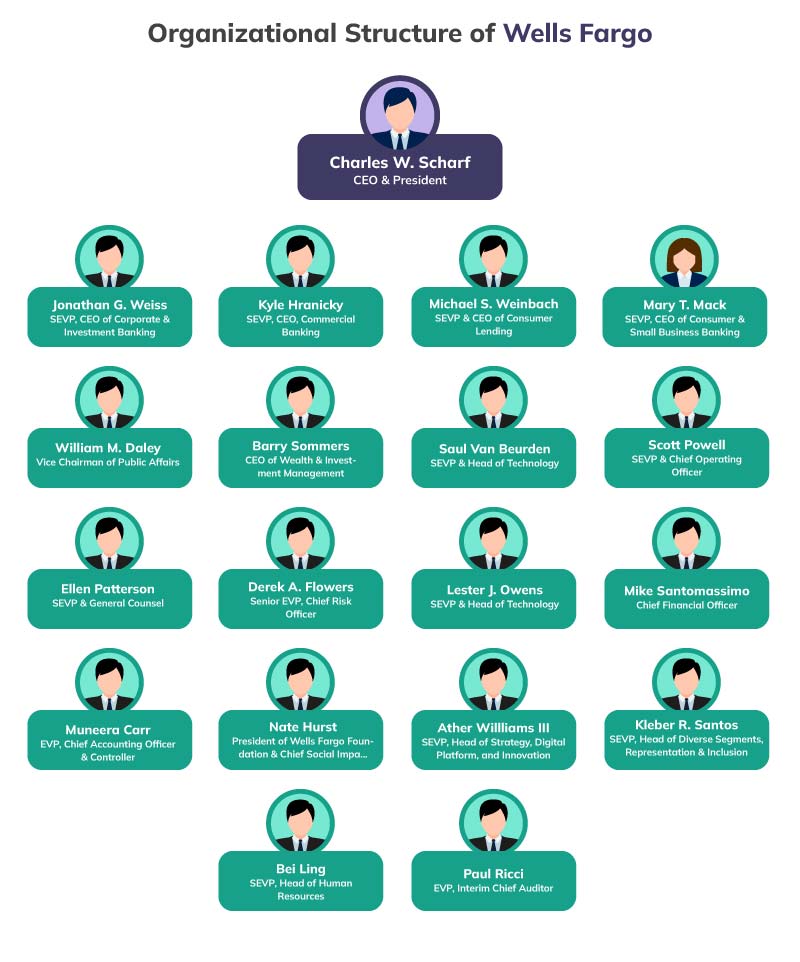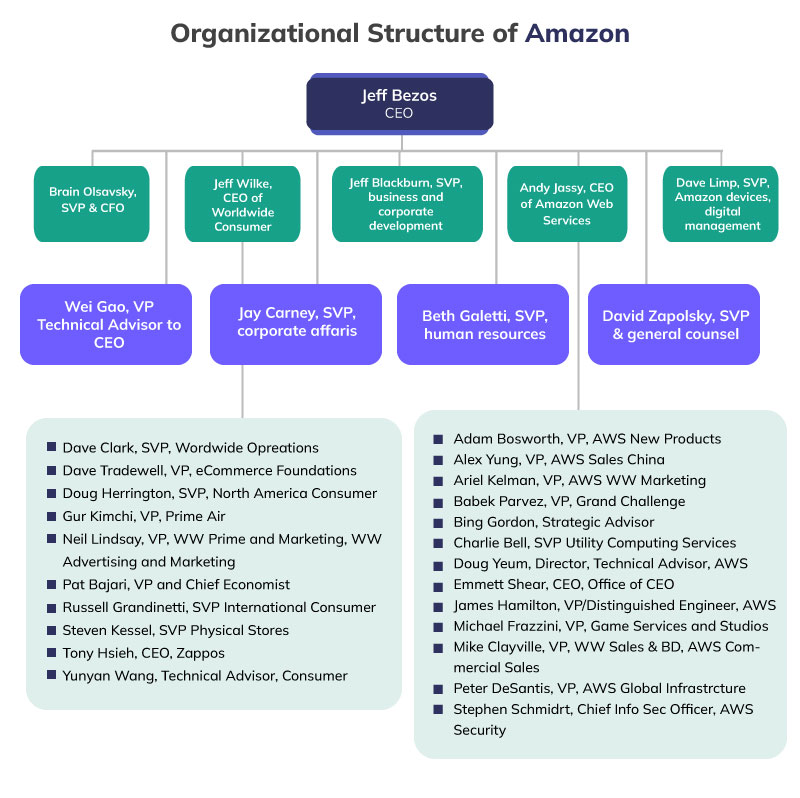Introduction to Hierarchical Organizational Structure
You must have heard about the organizational hierarchies. Hierarchies mainly relate to the system or organization that has many levels from bottom to top. The organizational hierarchies include the hierarchies within the organization i.e. levels of management between top management to employees. The hierarchical organizational structure is the pyramid-shaped organizational chart that represents the way the organizational operations are managed. You must be wondering if it is direct with the other organizational structures. Yes, all organizations have hierarchies and these hierarchies are represented by the hierarchical organizational structure. However, some organizations adopt a flat organizational structure to prevent hierarchical decision-making and bureaucracy within the organization.

Table of Contents
The hierarchical organizational structure is mainly used by organizations with a large number of employees to better manage the organizational processes by clarifying the reporting relations. The hierarchical organizational structure creates reporting relations within the organization under the top-down management system. The employee’s roles are also clearly identified in the hierarchical organizational structure as each employee works under a senior head who is responsible to delegate tasks to the employees. The hierarchical organizational structure includes a direct chain of command which encompasses a clear line of responsibility and accountability upon the management team members.
Advantages of Hierarchical Organizational Structure
Hierarchical organizational structure establishes a clear role and responsibility upon the employees in the organization and is more organized and stabilized due to the vertical chain of command. A hierarchical organizational structure is suitable for large companies to properly control all the operations of the organization by delegating clear roles and responsibilities to the employees. Hierarchical organizational structure can provide several benefits to the organization which are discussed as follows-
Clear reporting- One of the main advantages of the hierarchical organizational structure is clear reporting as a hierarchical organizational structure helps to establish a clear line of authority for various departments. Moreover, in the hierarchical organizational structure, the communication gets channeled over the chain of command which further generates a clear set of roles and responsibilities for the employees in the organization. This is also evidence from the organizational structure of Wells Fargo represented as follows-

The above represented organizational structure of Wells Fargo highlights that the number of hierarchies in the organization helps in clear reporting.
Organizational performance- Hierarchical organizational structure also helps to improve the organization’s performance by delegating the clear task to all the employees in the organization and organizing organizational operations in a manner that ensures effective resource allocation and a narrow span of managerial control. In the hierarchical organizational structure, each employee and the managerial head is held accountable for his/ her action which also helps to generate motivation among them to perform better.
Career path and specialization- Hierarchical organizational structure also provides a clear career path for the employees as there is a greater chance of promotion of the employees in the organization. The employees are also more likely to attain specialization in different fields as the organizations under this structure are likely to organize their tasks in different departments like human resources, marketing, etc., and employees working in the specific department can attain particular skill sets.
Disadvantages of Hierarchical Organizational Structure
Though hierarchical organizational structure provides a clear chain of command, the organizations operating under the hierarchical organizational structure are more likely to face bureaucracy at the workplace. Besides this, there are several problems associated with the flow of information and slow decision-making. Thus, the hierarchical organizational structure also has various disadvantages which are discussed as follows-
Flow of information- The main limitation of the hierarchical organizational structure is the flow of information. Generally, there is two-way communication within the organization i.e. from top to bottom and from bottom to top which helps to ensure efficiency in organizational operations. The flow of information from bottom to top is also needed so that the management team holds a complete set of information which then can have a significant impact on the organizational operations and strategies. However, in the hierarchical organizational structure, the flow of information is generally restricted from top to bottom which can lead to poor decision making in the organization.
Lack of flexibility- The level of flexibility in the hierarchical organizational structure is generally poor as all the decisions flow from the top to bottom with a lack of employee engagement in the decision-making. This further restricts the employee’s ability to adopt an innovative approach to various business problems. Moreover, change management is also an area of concern in the hierarchical organizational structure as lack of employee engagement and empowerment results in employee resistance to change.
Centralization of power- Hierarchical organizational structure results in the centralization of power in the organization. This can be challenging for the small business owner as instead of strategic planning and leadership, the owner can be caught in managing the day-to-day operations of the organization.
Example of Hierarchical Organizational Structure
We have seen that a hierarchical organizational structure is mainly adopted by large business organizations. Can you guess any such organization? Amazon, Starbucks, Apple, PepsiCo. Yes, all these organizations adopt the hierarchical organizational structure due to the large size of operations and the number of departments in each organization. Let’s consider the hierarchical organizational structure of Amazon.
Amazon is an American e-commerce and cloud computing company that offers a variety of products ranging from books to TV sets to car parts. Due to its large size, Amazon has adopted a hierarchical organizational structure whereby the company adopts a ‘top-down’ approach and a long chain of command. The hierarchical organizational structure of Amazon is managed over an overarching global hierarchy, geographical divisions, and Global groups based on functions.
Jeff Bezos exercises complete control over all the senior executives and managers in the organization who in turn direct other individuals or employees working under them considering the direction of Jeff Bezos. The three-tier organizational structure is followed at Amazon under which the global operations are managed through functional and divisional groups. Geographic divisions help the organization to effectively manage the e-commerce business over the global level. Function-based groups like finance, accounting, business development, Amazon Web Services, customer business, and international consumer business also help the organization to facilitate successful operation management throughout the organization. Large enterprises like Amazon may even rely on advanced tools such as AI accounting software to manage financial data efficiently across global divisions. Each organizational function has its functional head such as SVP or CEO who are responsible to manage the diverse functions in the organization. The organizational structure of Amazon is represented as follows-

The above organizational structure of Amazon represents the hierarchies in the organization which helps to ensure clear reporting and accountability in the organization. An advantage of a hierarchical organizational structure is that clarity in the tasks of each team member is facilitated. Also, the functional and divisional structure at Amazon helps to effectively implement the managerial directives. However, we also need to take into consideration that the hierarchical organizational structure at Amazon also leads to a decline in flexibility in the organization which then reduces the organization’s capacity to respond to diverse problems and challenges.
FAQs
Are hierarchical structures prevalent in all types of organizations?
No, hierarchical structures are not universal. While they are commonly seen in traditional organizations, other types, such as flat organizations or matrix structures, have emerged to address different needs and challenges.
How does a hierarchical structure impact career advancement opportunities?
Advancement is usually based on climbing the organizational ladder, with promotions coming as employees move up through different levels of management.
Previous Structure
Flat Organizational StructureNext Structure
Horizontal organizational structure
 Proof Reading
Proof Reading  Copy Writing
Copy Writing  Resume Writing
Resume Writing  Blogs
Blogs Guides
Guides SOP's
SOP's Student Resources
Student Resources Research Topics
Research Topics Login
Login Register
Register